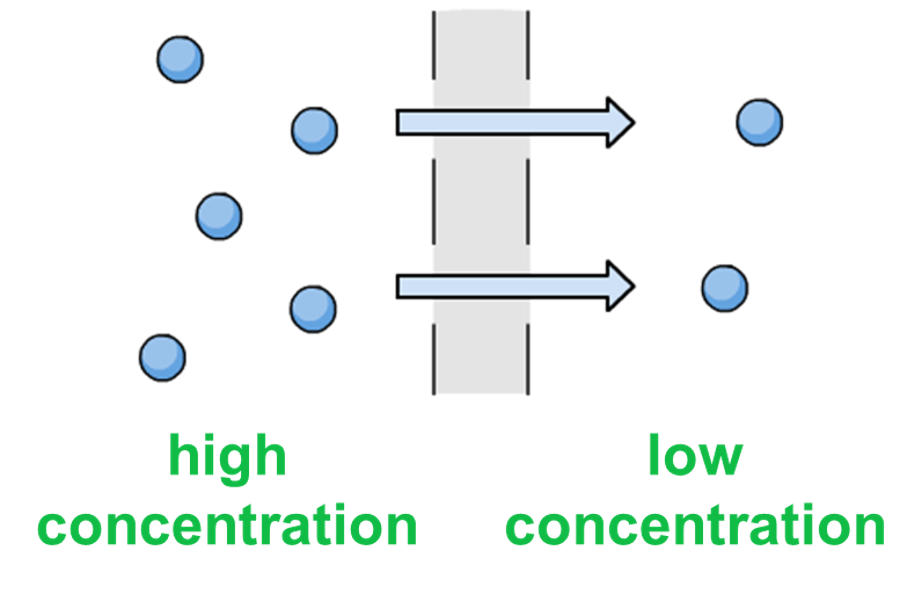B1 - Cell structure and Transport
1/39
There's no tags or description
Looks like no tags are added yet.
Name | Mastery | Learn | Test | Matching | Spaced |
|---|
No study sessions yet.
40 Terms
eyepiece
closes lens to eye, magnification of x10
arm
holds the eyepiece and lens above the stage
coarse focus
focuses the image to see clearly
fine focus
focuses the image to see clearly and sharply
revolving nose piece
holds the objective lens, can rotate
Objective lens
has 3 lenses of different strength to magnify the image more clearly
stage
where you put a microscope slide, clips hold the slide in place
diaphragm
Controls the amount of light that goes onto the microscope slide
light
projects light onto microscope slide, can use a mirror or light bulb
base
very heavy to prevent the microscope from falling over
Two types of microscopes
- light microscope - used in school
- electron microscope
How to use a light microscope
- place the slide with the specimen onto the stage.
- Ensure the lowest power objective lens is in place and the stage is as high as possible.
- look through the eyepiece
- adjust the coarse and fine focusing dials until the image is clear and sharp
- To increase magnification, twist the nose piece so the next highest objective lens is in place
- adjust the coarse and fine focusing dials again until the image is clear
A microscope has x5 eyepiece lens. Describe how to use this microscope to observe a prepared slide of root hair cells at a magnification of x50
The eyepiece lens magnifies x5 so you will need an objective lens of x10 to make the total magnification x50. Place the root hair cell on the stage and rotate the nosepiece to x10. You turn the coarse focus knob to see the root hair cells clearly and adjust the fine focus so the image is clear and sharp
cell membrane
controls what goes in and out
chloroplast
absorbs light energy to make food by photosynthesis and contains chlorophyll
cell wall
made of cellulose, strengthen the cells and gives it support
vacuole
filled with cell sap, keeps the cell rigid to support the plant
cytoplasm
liquid gel in which most of the chemical reaction need for life take place
nucleus
contains DNA, controls all the activities of the cell
mitochondria
releases energy during respiration
ribosome
where protein synthesis takes place
3 cells that plants have that animal don't
- chloroplast
- vacuole
- cell wall
Nerve cell - Location, Function and Adaptation
Location: Around the body
Function: To carry electrical impulses from one part of the body to another
Adaptation: Long axon carries nerve impulses from one part of the body to another.
Lots of Mitochondria to release energy needed to make chemicals which help cells to communicate
Muscle cells - Location, Function and Adaptation
Location: walls of blood vessels and hollow organs
Function: specialized to contract and relax
Adaptation: Lots of mitochondria, to release lots of energy for movement through aerobic respiration.
Special contractions protein to help change the size of muscle for movement
Sperm cells - Location, Function and Adaptation
Location: male parent
Function: fertilizes an egg
Adaptation: long tail to help the sperm move through the reproductive system.
Lots of Mitochondria which releases energy needed for movement
Red blood cells - Location, Function and Adaptation
Location: In blood
Function: Picks up oxygen from the air in your lungs, carry to the cell where needed
Adaptations: Lots of haemoglobin which binds to the oxygen.
No nucleus or mitochondria so more space for haemoglobin so more oxygen can be carried
Root hair cells - Location, Function and Adaptation
Location: close to the tips of growing root
Function: help them to take up water and mineral ions efficiently.
Adaptation: extended, long root hair increases the surface area so more water can enter (shape).
Many mitochondria are needed to transfer enough energy to help minerals and ions move into the cell
Palisade (leaf) cells - Location, Function and Adaptation
Location: Plants
Function: Can make their own glucose by photosynthesis
Adaptation: Many chloroplast with chlorophyll mean more light can be absorbed for photosynthesis. Photosynthesis is the process by which plant cells make glucose using sunlight.
Definition of diffusion and where does it occur
Movement of particles from an area of higher concentration to an area of lower concentrations, occurs across cell membrane

in which states can molecules diffuse?
molecules in liquids and gases are constantly moving and bumping into each other. This means that they tend to spread out.
How does the temperature affect the rate of diffusion?
An increase in temperature affects particles by diffusing very quickly using more kinetic energy
concentration gradient
Difference in concentration between two areas.
How does the concentration gradient affect the rate of diffusion?
The larger the difference in concentration, the higher the rate of diffusion.
what substances diffuse into animal cells?
Oxygen (from the lungs) and glucose (from digested food).
What substances diffuse out of animal cells?
Carbon dioxide (excreted via the lungs) and urea from liver cells (excreted via the kidneys).
What substance diffuses into plant leaves?
Carbon dioxide (for photosynthesis).
What substances diffuse out of plant leaves?
Oxygen and water (through the stomata)
3 features of a good gas exchange
Folded shape → larger surface area so more space for molecules to enter
Thin → to provide a shorter diffusion distance so diffusion rate increases
(in animals) efficient blood supply, always enough oxygen to keep a high concentration gradient.
active transport
Active transport is the movement of substances from a low concentration to a high concentration, using energy from respiration.
importance of active transport
When molecules need to move from low concentration to high concentration organisms use active transport. This requires energy to move molecules against a concentration gradient with the help of transport protein.